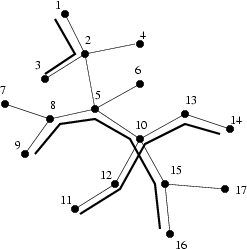 and
and  (
( ,
,  )
separated by a single space.
The number
)
separated by a single space.
The number  denotes the number of stations and the number
denotes the number of stations and the number  denotes the number of subway lines,
which are to be planned.
The stations are numbered from 1 to
denotes the number of subway lines,
which are to be planned.
The stations are numbered from 1 to  .
.A certain city has been coping with subway construction for a long time. The finances have been mismanaged and the costs have been underestimated to such extent that no funds were foreseen for the purchase of trains. As a result, too many stations and only some of the planned tunnels have been built - barely enough to allow a connection between any two stations to exist. The number of tunnels (each of them is bidirectional) is one less than the number of stations built. From the remaining funds only a handful of trains have been acquired.
To save their face the board of directors have asked you to plan subway routes in such a way as to allow maximal number of stations to be connected. Each train travels on a specified route. The routes cannot branch (no three tunnels starting at a single station may belong to the same route). Distinct routes may comprise the same station or tunnel.
Write a programme which:
The first line of the standard input contains two integers
 and
and  (
( ,
,  )
separated by a single space.
The number
)
separated by a single space.
The number  denotes the number of stations and the number
denotes the number of stations and the number  denotes the number of subway lines,
which are to be planned.
The stations are numbered from 1 to
denotes the number of subway lines,
which are to be planned.
The stations are numbered from 1 to  .
.
Each of the following  lines contains two distinct
integers separated by a single space.
The numbers
lines contains two distinct
integers separated by a single space.
The numbers  in the
in the  -th
line denote the numbers of stations connected by
-th
line denote the numbers of stations connected by  -th tunnel.
-th tunnel.
The first and only line of the standard output should contain a single integer denoting the maximal number of stations which can be covered by train routes.
For the input data:17 3 1 2 3 2 2 4 5 2 5 6 5 8 7 8 9 8 5 10 10 13 13 14 10 12 12 11 15 17 15 16 15 10the correct outcome is:
13

The figure represents the tunnel system (with subway routes marked) in one of the optimal configurations.